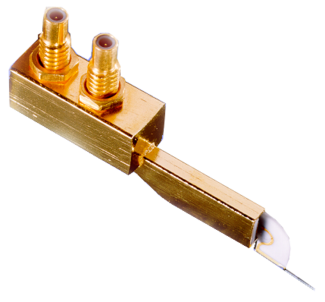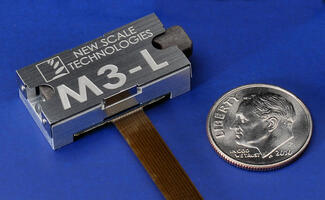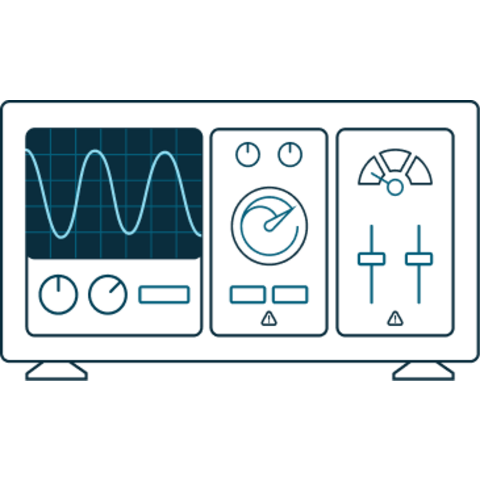NoiseKen - Fast Transient Burst / FNS-AX4-A20/B63
- IEC 61000-4-4 Ed.3 standard compliance.
- Pre-check function is installed. Inspection before testing is now easy.
- Normal mode test support. Taking account of field troubles is possible. (option)
- Utilize an outlet box that simplifies EUT connection. (option)
- Compared with conventional products, the size has become compact. (Approximately 67% by volume)
- Easy to understand Panel display reduces mistakes in connecting power cables.
- Software control with Windows. (option)
- Next calibration date can be notified. (Windows software only)
- Employ LCD screen with multi-language support and enhanced operability.
- Maximum output voltage of 5 kV and maximum pulse frequency of 2 MHz allow you to test above the standard test level.
- CDN capacity is increased to single phase type AC 240 V 20 A, single and three phase type to AC 600 V 63 A, supporting wider range of EUT.
- Large capacity CDN (100 A or 150 A) option available for Injection test on various EUT.
- Using coupling clamps, EMS probe kits, you can test the signal lines and evaluate the noise immunity on the PCB. (option)
Electrical fast transients (EFT), such as switching transients originating from inductive load interruption, relay contact bounce, etc., are one of the main causes of equipment malfunctions. Because they can occur anywhere interfering with circuits primarily via mains and interconnection cables.
EFT is characterized by fast rise times and a short duration of pulses. Also significant is the fact that EFT comes in bursts with repetition rates exceeding 100kHz. In the real world, an EFT event is a series of pulses with changing amplitudes and repetition rates. For test purposes, the IEC 61000-4-4 standard defines an idealized EFT/B. For anyone who wants to build quality products with an extensive test program from design, qualification, production to diagnostic purpose, the FNS-AX4 simulators will serve as a critical tool with a new level of performance and efficiency meeting and far exceeding the IEC standard requirements.
Output Waveform

PULSE OUT connector waveform:50Ω
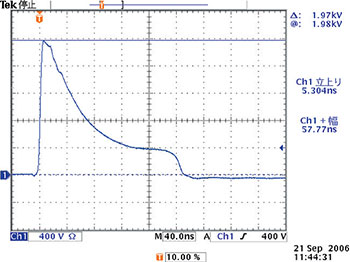
EUT LINE OUTPUT waveform:50Ω
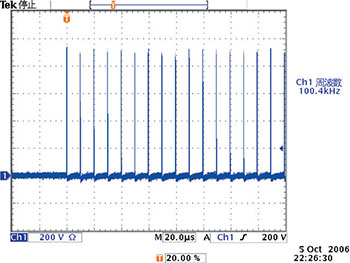
Repetitive pulses output as burst
Specification
Generator Specification
|
Parameter |
Specification / Function |
|---|---|
|
Output Voltage |
200 to 5000 V 10 V Step |
|
Polarity |
Positive or negative, polarity alternation possible per burst |
|
Repetition Frequency |
0.1 kHz to 2000 kHz 0.1 kHz to 1 kHz / 0.01 kHz step Tolerance ± 5%, 1.0 kHz to 10 kHz / 0.1 kHz step Tolerance ± 5% 10 kHz to 100 kHz / 1 kHz step Tolerance ± 5%, 100 kHz to 1000 kHz / 10 kHz step Tolerance ± 5% 1000 kHz to 2000 kHz / 100 kHz step Tolerance ± 10%, (Limitation per voltage levels when continuous output) |
|
Number of Pulses |
1 to 1000 at a step of 1 pulse , Setting limit: 1 pulse per ms in a burst (repetition frequency 1 kHz or more) |
|
Burst Duration |
Formula for Burst duration = Pulse number / Repetition Frequency Scope of manually setting value for burst duration: 0.01 to 999 ms |
|
Burst Period |
10 to 1000ms ± 10% 10ms steps (500ms or more for polarity alternate mode) |
|
Polarity Alternate Function |
Output polarity alternated between positive and negative at each burst period Setting condition: the burst period is 500ms or more and the burst pause period [(burst period) - (burst duration)] is 100ms or more Maximum test time: 10 minutes |
|
Continuous Pulse Output |
Up to 1000 V -10 kHz or less, to 2000 V -4 kHz or less, to 5000 V -1 kHz or less. Maximum test time for each case: 10 min |
|
Frequency Modulation |
Frequency is shifted continuously between set frequency and approximately -10% from the set frequency. The modulating wave is triangular wave of approximately 20Hz |
|
External Trigger |
External trigger input invokes 1 burst output in synchronization with the trigger input. Trigger specification: Hi (+ 5V) → Lo (0 V) triggers one burst period. |
|
Pulse Waveform (at 50 Ω load) |
Pulse peak voltage: (set voltage / 2) ± 10% Rise time: 5 ns ± 30% Pulse width: 50 ns ± 30% |
|
Pulse Waveform (at 1 kΩ load) |
Pulse peak voltage: (set voltage × 0.95) ± 20% Rise time: 5 ns ± 30% Pulse width: 35 to 150 ns |
|
DC Blocking Capacitor |
10nF ± 20% |
CDC Specification
|
Parameter |
Specification / Function |
|---|---|
|
Power Capacity |
A 20 model: Single phase AC 240 V / 20 A, DC 125 V / 20 A (10 A for PE) B 63 model: three-phase AC 600 V / 63 A, DC 125 V / 63 A (10 A for N / PE) |
|
Applied Phase |
A20 model: L / N / PE B63 model: L1 / L2 / L3 / N / PE Single line or all lines can be specified individually for each phase |
|
Injection Mode |
Common mode (Normal mode available using option) |
|
EUT Line Input/Output |
φ6 mm safety socket |
|
Coupling capacitor |
33 nF |
|
Output Waveform Specification |
Pulse peak voltage: (set voltage) / 2 ± 10% Rise time: 5.5 ns ± 1.5 ns Pulse width: 45 ns ± 15 ns Set voltage ± 4000 V, frequency specified from 5 kHz to 100 kHz |
|
Input Residual Voltage |
10% or less of setting pulse voltage EUT line input is 50 Ω termination, line output is defined as open |
|
AC Line Sync |
Synchronous and asynchronous setting available. Setting phase angle: 0 to 360 ° ± 10 ° 1 °Step Synchronizable voltage: AC 85 V to rated voltage Reference phase: between L-N (A20 model), L1-L2 (B63 model) |
Other Specification
|
Parameter |
Specification / Function |
|---|---|
|
Emergency Stop |
Push lock type switch (Test stop, EUT line OFF) |
|
EUT FAIL Function |
FAIL signal from external (Hi → Lo) detected during test FAIL signal specifications VLO: 0 V, VHI: + 5 V Choose operation from test stop / pause when triggered 3 channels available for the FAIL input |
|
External Interface |
REMOTE (For external PC control), CDN I/F (For external CDN), INDICATOR (For Warning Lamp or indicator lamp) EUT FAIL INPUT (For temporary pause at EUT failure event) |
|
Accessories |
Power Cable, SG Cable, Line Input Cable, Output Cable, Waveform Check Connector, Coaxial Cable, Operation Manual, Accessory bag |
|
Operating Environment |
Temperature 15 to 35 °C Relative humidity 25 to 75% |
|
External Dimensions / Weight |
(W)430 × (H)199 × (D)370 mm (excluding protrusions) / Approximately 14 kg (A20 model) and 22 kg (B63 model) |
|
Power Supply |
AC 100 to 240 V ± 10% 50/60 Hz approx. 120 VA |
1. Polarity Reverse Function
Enables to switch for putting the positive pulse and negative one out per the one burst so as to enrich the test.

2. Pulse continuous output / Frequency modulation function
Enables to switch for putting the positive pulse and negative one out per the one burst so as to enrich the test.

TEST SETUP

Test Method using Fast Transient / Burst Simulator
- Place the simulator onto the ground place which is connected to the protective earth and connect SG terminal on the front panel to the ground plane.
- Connect power cable (Standard accessory) to AC IN on the back of the simulator.
- Place coupling adaptor CA-805B (Option) onto the ground place and connect G terminal on side connector part of the clamp to the ground plane.
- Connect PULSE OUT connector on the front of the simulator to connector of the adaptor.(Fully pay attention to that any high voltage must not be put out during the connection)
- Thread cable to be tested through the adaptor.
- Set the test conditions like the coupling voltage, etc on the touch-panel on the front of the simulator and start the test.
